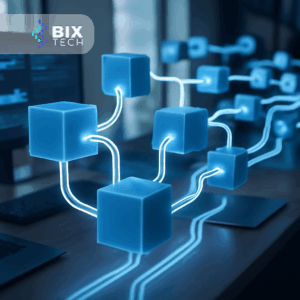If you’re a developer or have any interest in programming, APIs have probably crossed your path. But what exactly are APIs, and how can you start developing them? In this comprehensive guide, we’ll explore the world of APIs, covering the basics to advanced tips to refine your development skills. Keep reading and learn more about APIs with BIX!
What Are APIs?
We can’t kick off this guide without explaining the concept behind Application Programming Interfaces. APIs are sets of rules and protocols enabling different applications or software systems to communicate with each other. In simpler terms, they act as bridges connecting different parts of software or even different applications, allowing them to share data and functionalities.
Think of APIs as mailboxes in an apartment building. Each mailbox represents a specific function or feature that an application offers. Other applications can send letters (requests) to these mailboxes and receive responses (data or actions) in return. APIs define the rules for sending and receiving these letters, ensuring communication is efficient and secure.
Taking a practical example: imagine you have a server with sales data and need to grant specific access to information for a different system (e.g., one used by your organization’s business team). As these are different vendor systems with no direct connection, facilitating this information exchange in a non-manual way is necessary—manual intervention would be cumbersome. This is where APIs come into play: they assist in bridging the gap between the two servers, requiring only a request to initiate this integration.
The Advantages of APIs
APIs play a crucial role in the technology world, offering a range of benefits that drive innovation and efficiency in businesses. Here are four key advantages:
- Integration: APIs bring agility to generate new digital experiences and establish new touchpoints. This accelerates development speed, as each functionality doesn’t need to be written from scratch.
- Innovation: With the arrival of new applications, companies need to respond quickly and provide support in deploying these new systems into their services. In this sense, APIs help facilitate this work without the need to rewrite an entire codebase.
- Expansion: APIs provide a unique opportunity for companies to meet customer needs across different platforms, ensuring that the connection throughout the value chain is swift and uncomplicated.
- Ease of Maintenance: APIs act as a gateway between two systems, and each system is required to make internal changes to ensure the API is not affected. This way, any future code changes made by one party or the other won’t impact the other.
API Lifecycle
Much like living beings, APIs also have their lifecycle. There’s no real consensus on how many stages are involved, as it varies among authors. However, the central idea remains the same. In this article, we’ll consider seven stages:
- Planning: This stage is vital for the entire API lifecycle. It’s advisable to think about different use cases to ensure it aligns with development standards, defining resources, operations, security standards, among other topics. Well-executed planning reduces the chances of issues, changes, or setbacks.
- Design or Project: At this phase, an API interface is created. This involves documenting parameters, resources, authentication, authorization, code, error handling, and other details. Clearly describing documentation is crucial at this stage.
- API Development: API designers prototype the API based on the code defined in the previous stage. Once this prototype is tested, developers can customize it according to internal specifications
- Testing: API testing is similar to software development testing. The primary goal is to prevent bugs and defects, and testing tools can be used to test the API’s resilience against external attacks. Tools like Postman, for example, can be used for these tests.
- API Publication: After undergoing rigorous testing, the API is finally ready to be published. Here, a secure and scalable production environment is configured to host the API. Additionally, it’s essential to review and update documentation to reflect the final version of the API.
- Monitoring: Once the API is published, continuous monitoring of the technology is crucial. This makes it easier to identify any problems that may occur and implement improvements as needed, among other activities. Regular observation is necessary to ensure all security and audit requirements are met.
- API Discontinuation: At some point, discontinuing an API may be necessary. This is a common process; however, it’s important to note that there’s no set timeframe within this cycle. It may occur due to a change in business needs, technology becoming obsolete over time, among other reasons. Regardless, when your API reaches this stage, creating a discontinuity plan is important, informing users of its termination.
Tools in API Development
When it comes to API development tools, various useful systems are available. Here are some of the most popular:
- Postman: Widely used for testing and documenting APIs, Postman also comes with additional functionalities.
- Swagger Editor: Similar to Postman in some aspects, Swagger Editor shines when it comes to documentation. It offers various testing functionalities.
- Google Cloud Functions, Azure Functions, and AWS Lambda: Clouds are also excellent options for API development tools. All of them cost between $0.20 and $0.40 (subject to change), with pricing per million requests.










